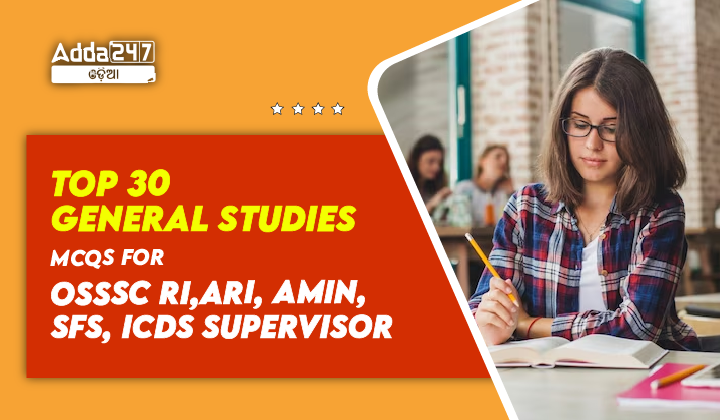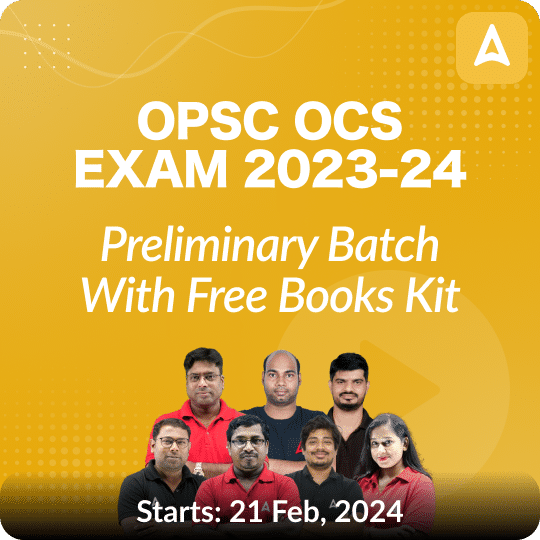Top 30 General Studies MCQS For OSSSC RI,ARI, Amin, SFS, ICDS Supervisor
Preparing for competitive exams like the OSSSC RI, ARI, Amin, SFS, and ICDS Supervisor requires a solid grasp of general studies. Here are the top 30 multiple-choice questions (MCQs) along with their answers:
Q1. Siraj-ud-daulah renamed which city as alinagar?
(a)Calcutta.
(b) Agra.
(c) ferozpur.
(d) fatehpur.
S1. (a)
Sol.
siraj-ud-daulah renamed Calcutta as alinagar., The treaty of alinagar was signed on 9th Feb 1757 between Robert Clive and siraj-ud-daulah .
Q2. The ‘Junagarh Rock Inscription’ associatedto?
(a) Rudradaman
(b) Bimbisara
(c) Chandragupta II
(d) GautamiputraSatakarni
S2. Ans.(a)
Sol.
- The Junagadh rock inscription of Rudradaman, also known as the Girnar Rock inscription of Rudradaman, was inscribed by the Western Satraps ruler Rudradaman I.
- It is located in Girnar near Junagadh, Gujarat, India, and dated to circa 130–150 CE.
Q3. Nalanda University was a great centre of learning, especially in
(a) Buddhism
(b) Jainism
(c) Vaishnavism
(d) Tantra
S3. Ans.(a)
Sol.
- Nalanda was a Mahavihara, a large Buddhist monastery, in the ancient kingdom of Magadha (modern-day Bihar) in India. The site is located about 95 kilometres southeast of Patna near the town of Bihar Sharif, and was a centre of learning from the fifth century CE to c. 1200 CE. It is a UNESCO World Heritage Site.
Q4. The paintings in the Ajanta and Ellora caves are indicative of development of art under the?
(a) Rashtrakutas.
(b) Pallavas.
(c) pandyas.
(d) Challykyas.
S4. (d)
Sol.
- The paintings in Ajanta and Ellora caves developed under the Challykyas.
Q5.The capital of the maurayan kingdom was located at?
(a) Pataliputra.
(b)Vaishali.
(c) Lumbini.
(d) Gaya.
S5. (a)
Sol.
- The capital of Mauryan kingdom was pataliputra.
Q6. The words “Satyameva Jayate” in the State Emblem of India were taken from
(a) Mundaka Upanishads
(b) Sama Veda
(c) Rig Veda
(d) Ramayana
S6. Ans.(a)
Sol.
- “SatyamevaJayate” is a mantra from the ancient Indian scripture Mundaka Upanishad.
Q7. The famous rock-cut temple of Kailasa is at
(a) Ajanta
(b) Badami
(c) Mahabalipuram
(d) Ellora
S7. Ans.(d)
Sol.
- TheKailasanatha temple (Cave 16) is one of the 32 cave temples and monasteries known collectively as the Ellora Caves.
- Its construction is generally attributed to the 8th century Rashtrakuta king Krishna I in 756-773 CE. The temple architecture shows traces of Pallava and Chalukya styles.
Q8. From where did Acharya VinobaBhave start the individual satyagraha in1940?
(a) SardarVallabhbhai Patel.
(b) DRM B.R. Ambedkar.
(c) sir alladiKrishnaswamyayyar.
(d) pt. Jawahar Lal Nehru.
S8. (d)
Sol.
- jawahar Lal Nehru was the chairman of the union power’s committee of the constituent assembly.
Q9. What was the main motive of Third Five Year Plan in India?
(a) Rural development
(b) Agriculture
(c) Financial inclusion
(d) Economicreform
S9. Ans.(b)
Sol.
- The primary goal of the Third Plan was to establish India as a self-reliant and a self-generating economy.
- The Third 5 year Plan also focused on agriculture enhancement in the production of wheat.
Q10. In the context of Indian economy, which of the following is a subject under the tertiary sector?
(a) Health
(b) Agriculture
(c) Industries
(d) Animal husbandry
S10. Ans.(a)
Sol.
- In the context of Indian economy, Health sector is a subject under the tertiary sector.
- The tertiary sector of the economy, generally known as the service sector.
Q11. Inflation in India is measured on which of the following indexes / indicators?
(a)Cost of Living Index (CLI)
(b)Consumer Price Index (CPI)
(c)Gross Domestic Product (GDP)
(d)Wholesale Price Index (WPI)
S11. Ans.(b)
Sol.
- Inflation rates in India are usually quoted as changes in the Wholesale Price Index (WPI), for all commodities.
- In India, CPI (combined) is declared as the new standard for measuring inflation from April 2014.
Q12.When too much money is chasing to few goods , the situation is?
(a) Deflation.
(b)Inflation.
(c) Recession.
(d)Stagflation.
S12. (b)
Sol.
- Inflation is general rise in price level of commodity.
- In other words , it means due to increase in money supply , rise in price level. That means too much money chasing few goods.
Q13. Taxes on professions can be levied by?
(a)State government only.
(b)Both by State government and union government.
(c)By panchayats only.
(d)union government only.
S13. (a)
Sol.
Professional tax is tax levied by State government on all persons who practice any profession.
Q14.Who had estimated national income in India first?
(a)V.K.R.V. Rao.
(b)DadabhaiNaoroji.
(c) R.C.Dutt .
(d) D.R. Gadgil.
S14. (b)
Sol.
DadabhaiNaoroji estimated national income in India for the first time in 1876. Mainly calculationwas done by estimating the value of agricultural and non- agricultural production.
Q15.which of the following group’s suffer the most from inflation?
(a) Debtor’s.
(b)creditor’s.
(c) Business Class.
(d) Holders of real assets.
S15. (b)
Sol.
- Inflation devalues currency so it helps borrower to pay less than value of money he has borrowed.
- Devaluation of money affect creditors badly because the money received back will be of less value.
Q16.The amount of energy as it passes on from one trophic level to other in an ecosystem
(a) increases
(b) decreases
(c) remains constant
(d) none of these
S16. Ans. (b)
Sol. The amount of energy in an ecosystem decreases as it passes from one trophic level to other. As for example, in a food chain not 100 percent of energy is transferred from one trophic level to the other as only a fraction of it is transferred and rest is lost to the atmosphere.
Q17. Who was the discoverer of human blood groups?
(a) Landsteiner
(b) Livine
(c) Vinear
(d) Leeuwenhoek
S17.Ans. (a)
Sol. Karl Landsteiner is credited for the discovery of human blood groups. He also won the 1930 Nobel Prize for Physiology or Medicine for the same.
Q18. Total interacting and animals and plants in any well-defined area is known as?
(a) population.
(b) Biome.
(c) Community.
(d) species.
S18. (c)
- Community is an assemblage of biotic population including plants and animals which lives in a particular habitat.
Q19. Who discovered penicillin?
(a) Edward Jenner.
(b) Niels Bohr.
(C) Sir Alexander Fleming.
(d) Heinrich Hertz.
S19.(c)
- Sir Alexander Fleming is the discoveror of penicillin.
Q20. Syrinx is the voice box in?
(a) Amphibians.
(b) Reptiles.
(C) Bird’s.
(d) Mammals.
S20.(c)
- Syrinx is the vocal organ of the bird’s.
- Sound is produced by vibration of all the membrane tympaniform , syrinx enables some species of bird’s to mimic the human sound.
Q21.”Sirius”, the brightest star outside solar system, is also called ______
(a) Cat star
(b) Dog star
(c) Fox star
(d) Lion star
S21. Ans.(b)
Sol.The brightest star visible from any part of Earth is Sirius in the constellation Canis Major the Greater Dog. Sirius is sometimes called the Dog Star.
Q22. In terms of size, Jupiter ranks no. ___ in our Solar System.
(a) 1
(b) 2
(c) 3
(d) 4
S22. Ans.(a)
Sol.Planets in our Solar system size comparison (top to bottom): Jupiter, Saturn, Uranus, Neptune, Earth, Venus, Mars, Mercury.
Q23. Which one of the following countries is the largest country without borders in terms of geographical area?
(a) New Zealand
(b) Philippines
(c) Japan
(d) Cuba
S23.Ans(c)
Sol. In the given options Japan is the largest country without borders in terms of geographical area.
Japan – 377,915 km2
Philippines – 300,300 km2
New Zealand – 270,467 km2
Cuba – 109,844 km2
Q24. The country which has the longest north-south (latitudinal) extension of its territory is-
(a) Russia
(b) Chile
(c) China
(d) Brazil
S24.Ans(b)
Sol. Chile is the world’s longest country from north to south measuring at 4,620 km (2,647mi).
Q25. Naku La Pass is situated in?
(a) Arunachal Pradesh
(b) Manipur
(c) Sikkimx
(d) J&K
S25.Ans(c)
Sol. Nathu La is a mountain pass in the Dongkya Range of the Himalayas between Yadong in Tibet, and the Indian states of Sikkim.
Q26. Which of these is NOT included as a Fundamental Right in the Indian Constitution?
(a) Right to freedom to speech
(b) Right to equality before Law
(c) Right to constitutional remedies
(d) Right to equal wages for equal work
S26. Ans.(d)
Sol.
The six fundamental rights recognised by the Indian constitution are the right to equality, right to freedom, right against exploitation, right to freedom of religion, cultural and educational rights, right to constitutional remedies.
Q27. Which fundamental right is called as the heart and soul of the Indian Constitution?
(a) Right to constitutional remedies
(b) Right to freedom to speech
(c) Right to equality before Law
(d) Right to freedom of religion
S27. Ans.(a)
Sol.
Dr. B.R.Ambedkar called ‘Article 32’ of the Indian Constitution i.e. Right to Constitutional remedies as ‘the heart and soul of the Constitution’.
Q28. Right to property was removed from the list of Fundamental Rights during the rule of:
(a) Indira Gandhi Government
(b) Morarji Desai Government
(c) Narasimha Rao Government
(d) Vajpayee Government
S28. Ans.(b)
Sol.
The 44th amendment to the Indian Constitution was passed after the revocation of internal emergency in 1977. It was instead made a constitutional right under Article 300A which states that. ” No person can be deprived of his property except by authority of law.”
Q29. Political right does NOT include which of the following?
(a) Right to vote
(b) Right to life
(c) Right to contest in election
(d) Right to lodge complaint with executive bodies of the Government
S29. Ans.(b)
Sol.
The Constitution of India provides Fundamental Rights under Chapter III. Article 21. Protection Of Life And Personal Liberty: No person shall be deprived of his life or personal liberty except according to procedure established by law.
Q30. Which of the following rights is NOT granted by the Constitution of India at present as a fundamental right?
(a) Right to equality
(b) Right to freedom
(c) Right to property
(d) Right against exploitation
S30. Ans.(c)
Sol.
In the year 1977, the 44th amendment eliminated the right to acquire, hold and dispose of property as a fundamental right. However, in another part of the Constitution, Article 300 (A) was inserted to affirm that no person shall be deprived of his property save by authority of law.










